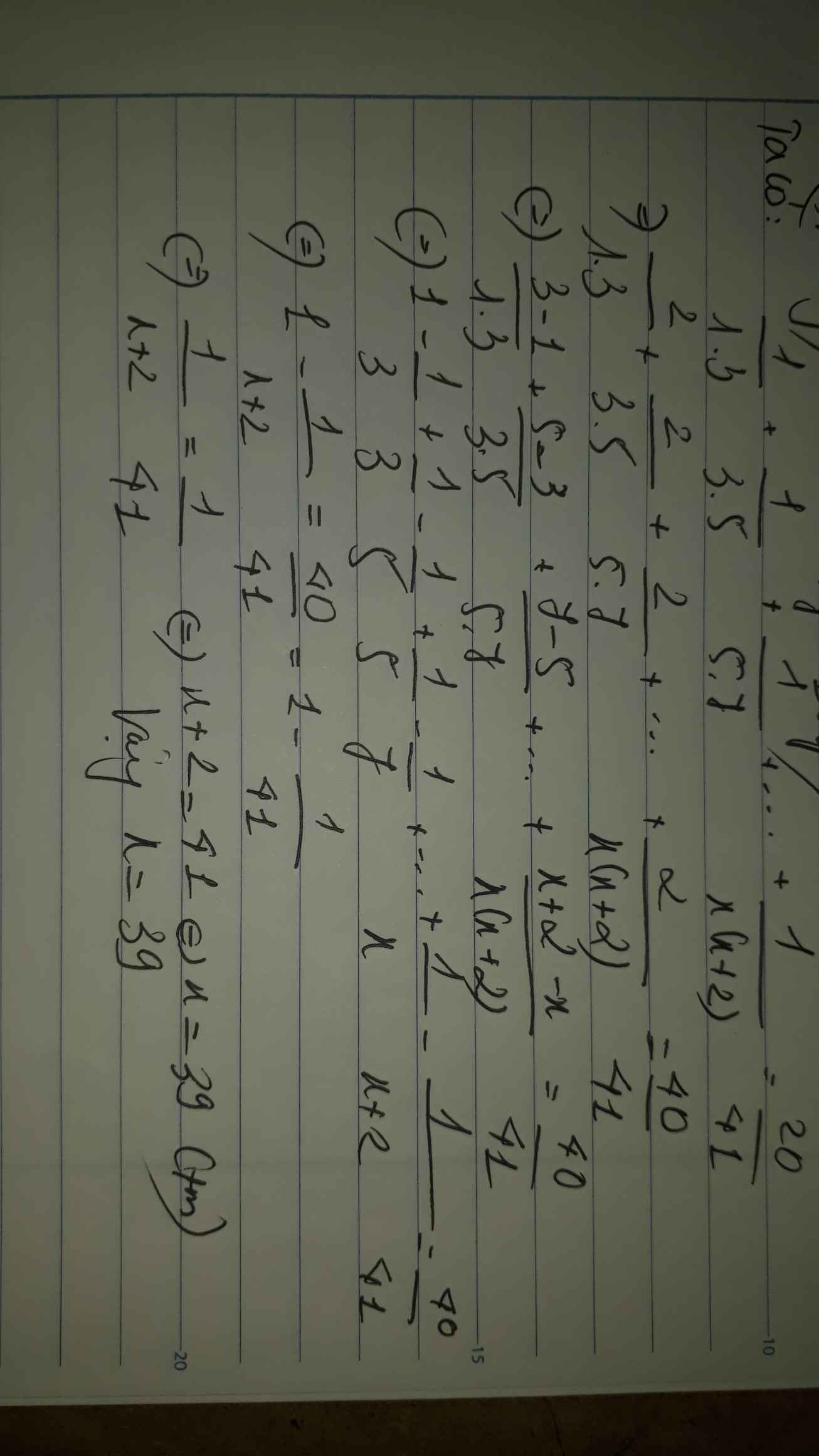
Hãy nhập câu hỏi của bạn vào đây, nếu là tài khoản VIP, bạn sẽ được ưu tiên trả lời.


\(0,27+\frac{1}{2}< x\%< 1-20\%\)
\(\Leftrightarrow\frac{27}{100}+\frac{50}{100}< \frac{x}{100}< \frac{80}{100}\)
\(\Leftrightarrow\frac{77}{100}< \frac{x}{100}< \frac{80}{100}\)
\(\Rightarrow77< x< 80\)
Mà x thuộc Z nên \(x\in\left\{78;79\right\}\).
Vậy ...

a: =>3x-15=2x-22
=>x=7
b: =>0,27+0,5<x/100<1-0,2
=>0,77<x/100<0,8
=>77<x<80
hay \(x\in\left\{78;79\right\}\)

\(-\dfrac{1}{8}< \dfrac{x}{72}\le-\dfrac{1}{36}\)
\(\Rightarrow\dfrac{-9}{72}< \dfrac{x}{72}\le-\dfrac{2}{72}\)
\(\Rightarrow x\in\left\{-8;-7;-6;-5;-4;-3;-2\right\}\)

1, để \(\dfrac{2x+1}{x+3}\) là 1 số nguyên
= > 2x + 1 chia hết cho x + 3 ( x thuộc Z và x \(\ne3\) )
= > 2 ( x + 3 ) - 5 chia hết cho x + 3
=> -5 chia hết cho x + 3
hay x + 3 thuộc Ư(-5 ) \(\in\left\{\pm1;\pm5\right\}\)
Đến đây em tự tìm các giá trị của x
2, Tương tự câu 1, x - 1 chia hết cho x + 5 ( x thuộc Z và x khác - 5 )
= > - 6 chia hết cho x + 5
= > \(x+5\in\left\{\pm1;\pm2;\pm3;\pm6\right\}\)
....
3, ( x - 1 ) ( y - 3 ) = 7
x,y thuộc Z = > x - 1 ; y - 3 thuộc Ư(7)
và ( x - 1 )( y - 3 ) = 7
( 1 ) \(\left\{{}\begin{matrix}x-1=1\\y-3=7\end{matrix}\right.\Leftrightarrow\left\{{}\begin{matrix}x=2\\y=10\end{matrix}\right.\)
(2) \(\left\{{}\begin{matrix}x-1=7\\y-3=1\end{matrix}\right.\Leftrightarrow\left\{{}\begin{matrix}x=8\\y=4\end{matrix}\right.\)
( 3) \(\left\{{}\begin{matrix}x-1=-1\\y-3=-7\end{matrix}\right.\Leftrightarrow\left\{{}\begin{matrix}x=0\\y=-4\end{matrix}\right.\)
( 4 ) \(\left\{{}\begin{matrix}x-1=-7\\y-3=-1\end{matrix}\right.\Leftrightarrow\left\{{}\begin{matrix}x=-6\\y=2\end{matrix}\right.\)
Từ ( 1 ) , ( 2 ) , ( 3 ) , ( 4 ) các cặp giá trị ( x,y ) nguyên cần tìm là ....

Ta có : \(A=\dfrac{x^2+2x+1-4x-4+4}{x+1}\)
\(=\dfrac{\left(x+1\right)^2-4\left(x+1\right)+4}{x+1}=x+1-4+\dfrac{4}{x+1}\)
- Để A là số nguyên
\(\Leftrightarrow x+1\inƯ_{\left(4\right)}\) ( Do x là số nguyên )
\(\Leftrightarrow x+1\in\left\{1;-1;2;-2;4;-4\right\}\)
\(\Leftrightarrow x\in\left\{0;-2;1;-3;3;-5\right\}\)
Vậy ....

Nhân cả 2 vế với 3 ta có:
\(pt\Leftrightarrow2x-\dfrac{6}{y}=1\Leftrightarrow2x=1+\dfrac{6}{y}\)
Nhận thấy rằng 2x là số nguyên, 1 là số nguyên nên \(\dfrac{6}{y}\) cũng là số nguyên
=> y ∈ Ư(6) = {\(\pm\)1; \(\pm\)2; \(\pm\)3; \(\pm\)6}
Mà 2x là số chẵn => \(1+\dfrac{6}{y}\) là số chẵn => y ∈ {\(\pm\)2; \(\pm\)6}
+) \(y=-6\Rightarrow x=\dfrac{1}{2}\left(1+\dfrac{6}{-6}\right)=0\)
+) \(y=-2\Rightarrow x=\dfrac{1}{2}\left(1+\dfrac{6}{-2}\right)=-1\)
+) \(y=2\Rightarrow x=\dfrac{1}{2}\left(1+\dfrac{6}{2}\right)=2\)
+) \(y=6\Rightarrow x=\dfrac{1}{2}\left(1+\dfrac{6}{6}\right)=1\)

Ta có: \(\dfrac{1}{1\cdot3}+\dfrac{1}{3\cdot5}+\dfrac{1}{5\cdot7}+...+\dfrac{1}{x\left(x+2\right)}=\dfrac{20}{41}\)
\(\Leftrightarrow\dfrac{2}{1\cdot3}+\dfrac{2}{3\cdot5}+\dfrac{2}{5\cdot7}+...+\dfrac{2}{x\left(x+2\right)}=\dfrac{40}{41}\)
\(\Leftrightarrow1-\dfrac{2}{x+2}=\dfrac{40}{41}\)
\(\Leftrightarrow\dfrac{2}{x+2}=\dfrac{1}{41}\)
Suy ra: x+2=82
hay x=80

\(4)\)
\(\dfrac{-\left(-x\right)}{5}-\dfrac{2}{10}=\dfrac{1}{-5}-\dfrac{7}{50}\)
\(\Leftrightarrow\dfrac{x}{5}-\dfrac{2}{10}=\dfrac{1}{-5}-\dfrac{7}{50}\)
\(\dfrac{2x}{10}-\dfrac{2}{10}=\dfrac{-10}{50}-\dfrac{7}{50}\)
\(\Leftrightarrow\dfrac{2x-2}{10}=\dfrac{-10-7}{50}\)
\(\dfrac{2x-2}{10}=\dfrac{-17}{50}\)
\(\Leftrightarrow50\left(2x-2\right)=-17.10\)
\(100x-100=-170\)
\(100x=-170+100=-70\)
\(x=-70:100=\dfrac{-7}{10}\)
\(\dfrac{x+1}{5}=\dfrac{7}{x-1}\)
\(\left(x+1\right)\left(x-1\right)5.7\)
\(x\left(x-1\right)+1\left(x-1\right)=35\)
\(x^2-x+x-1=35\)
\(x^2-1=35\)
\(x^2=36\)
\(\Leftrightarrow x=\left\{\pm6\right\}\)
bạn có thể giải đc các bài còn lại k ? K phải mk ép bạn đâu nhưng nếu bạn lm đc thì giúp mk nha

Giải:
\(0,27+\dfrac{1}{2}< x\%< 1-20\%\)
\(\Leftrightarrow\dfrac{77}{100}< \dfrac{x}{100}< \dfrac{4}{5}\)
\(\Leftrightarrow\dfrac{77}{100}< \dfrac{x}{100}< \dfrac{80}{100}\)
\(\Leftrightarrow77< x< 80\)
\(\Leftrightarrow x=\left\{78;79\right\}\)
Vậy ...
\(0,27+\dfrac{1}{2}< x\%< 1-20\%\)
\(\Rightarrow\) \(\dfrac{27}{100}+\dfrac{50}{100}< \dfrac{x}{100}< \dfrac{100}{100}-\dfrac{20}{100}\)
\(\Rightarrow\) \(\dfrac{77}{100}< \dfrac{x}{100}< \dfrac{80}{100}\)
\(\Rightarrow\) \(77< x< 80\)
\(\Rightarrow\) \(x\in\left\{78;79\right\}\)
Vậy \(x\in\left\{78;79\right\}\)